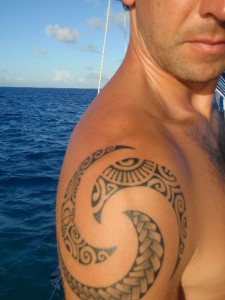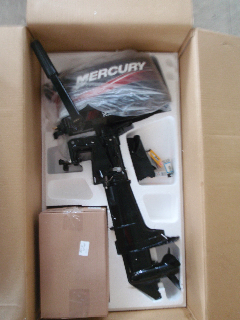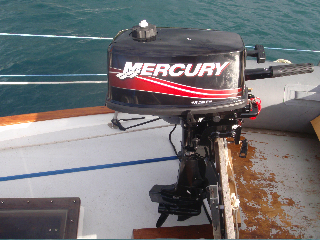Jan 12 2011
Surviving a Flood
I gunned the engine fighting to move forward in the 4 knot current that was rushing through and under our marina. The four knot current looked tame compared to the 10 knots of the river. I had only 20 feet of room forwards and backwards within which to maneuver. The dinghy trailing behind me had already banged into the dock behind me once and I had twice nearly missed banging into the boats in front of me. Five people were managing the two dock lines that were holding me against the current. Somehow, Syzygy had been chosen to be the first of three single-handed sailboats out of the marina. With all of us lined up right next to each other, we were hoping to figure out a way to get us out. We needed to get out because the latest flood predictions were that in 24 hours the river would rise enough to lift the marina dock above the pylons that allow for the dock to rise and fall with the tide. If the docks got above those pylons, the flimsy gang plank leading from land to the docks, the only actual solid tethering the docks have, would be no match for the rushing river. The dock would start to whisk away along with boats still tied to the dock. You can imagine that the keel of any boat would inevitably crash into the just submerged concrete pylons, massive damage would ensue.
It didn’t seem possible that flooding of this magnitude could happen. Brisbane is an an area of Australia called the Sunshine Coast. It’s supposed to be sunny. Not epic rain. They did have an epic flood here in 1974, but afterwards built a dam that was supposed to be able to contain any flood imaginable. Apparently rain 40 out of the last 50 days didn’t fit into the designers’ imagination. I had been melancholy and miserable over the month; the rain makes it difficult to a) get any work done on the boat and b) to have much fun around town. But up until two days ago, I didn’t give a single concern to the safety of the boat.
Here’s an excerpt from an e-mail I sent to Gary on the 10th:
“The Brisbane River is a small catchment, you only have to go a short way, and rivers start flowing west instead of east towards the ocean, which is crazy. So that and flow controls on the Brisbane River itself mean there is no flooding here. However, to the north and to the west they are not so lucky and flooding has been of biblical proportions. I read somewhere that an area the size of France and Germany combined is under water. “
Everyone, every-one… said the Wivenhoe Dam would make floods like 1974 impossible. Then at 3 pm on Tuesday marina residents got an e-mail from the marina office forwarding on the most recent flood warning and politely saying, ‘Get the hell out of here.’ A mass exodus of boats left immediately. I spent the next 6 hours hurriedly getting the boat back into shape to be sailed; half finished projects were everywhere. All of the reef lines were in the sail were off. The sail wasn’t fastened to the mast track in places while I worked on the batons and baton pockets in the main sail. The rail boards we tie our extra water and fuel containers to were off and the containers strewn idly about the deck. The automatic bilge pump wasn’t working.
I and a dozen other boats talked and discussed and planned for a departure the next morning just after low tide Wednesday. The hope was that the tide coming in would partially mitigate the strong current heading out making the current easier to manage. And then, we watched the carnage float by. We watched as boats passed by spinning wildly. They were probably from private docks of people who live on the river bank upstream, were clearly unmanned and had simply torn free from their dock. Other boats floated by still attached to the the dock, the entire dock having ripped away from land. A boat still on air pontoons which keep it out of the water floated by. Another boat floated by attached to it’s dock. On the dock was an electrical box still intact, a gas grill bolted to the dock and a jet ski mounted there. The entire ensemble pirouetted by, rushing towards the sea.
We also just waited. And the waiting was difficult. A lot of time to think about how to actually get the boat out. Too much time to think about what could go wrong. Plenty of time to question whether, honestly, I was up to this. I reflected on my lack of experience. I’ve never captained this boat before. I’ve never single-handed. I’ve never been alone with the decisions on me, and me alone. I reviewed my meager sailing resume in my mind. I just learned to sail three years ago and ever since, even if I was calling the shots on board, there was always someone, Matt, in the end to nod, confirm and assist if shit went wrong.
To my family and Allison I e-mailed: “Don’t worry, I’ll be fine.” To Matt, the title of my e-mail was: URGENT and I went over preparations and what needed to be done, soliciting advice, counsel and a reassuring tone. He knows the boat and right now that’s what I needed.
Because I was driving myself crazy with anxiety and nervousness. My first adventure as captain wasn’t supposed to be until March. A friend of mine with some sailing experience would be joining and I would captain us out in easy, fair conditions. We would go sailing and enjoy ourselves as we soaked in the sun, leisurely meandering our way up the Australian Coast. Starting out in a high stress situation was not what I had anticipated.
Syzygy had been sitting in it’s dock facing down stream, it’s fat bottom aft was upriver. The plan was to slowly ease out of the slip and start to turn towards the marina exit. As soon as I started to turn the current would catch the boat and whip it around. Lines from the front of the boat would still be attached to the dock, so Syzygy would do a nice 180 degree turn and then be facing up river. Facing upriver would allow me more control over the boat; I could use the engine much more effectively to battle the current and maneuverability would be better facing into the current. Then work the dock lines holding the bow to the dock from one finger of the dock to the next until we were at the end of the dock and next to the marina exit. Then gun the engine forward, let the bow lines off, turn the nose into the river and gun the engine more to get the boat far enough into the river so that it didn’t crash sidelong into the dock 20 feet away from Syzygy’s rear. This was the plan. The plan wasn’t going so well.
After being eased slowly out, just as planned the boat started to rotate around, pivoting on two lines tied to the bow of Syzygy and to the dock. I had to gun the engine and get the boat moving forward into the current. As anticipated there wasn’t enough room for the back end of the boat to simply drift down and swing around. That would have required at least 80 feet, probably 100. We only had 70 feet to work with. But the turn was managed and Syzygy was now facing upriver and held on by two dock lines. We then spent the next 45 minutes trying to get Syzygy closer to the marina exit. We moved one dock line closer to the marina exit. I would let Syzygy drift back twenty feet, until it was nearly touching the fingers of the dock behind me. Then gunning the engine I fought upstream within the 70 foot space between docks, trying to turn towards the marina exit, trying to inch the boat closer to the exit. Coordinating my actions at the helm with the people manning the lines, when to ease one line or pull in another, was frustratingly close to futile. Turning our 12 ton sailboat in calm water is a slow momentum laden process. Pulling into a dock in calm water with even the tiniest amount of wind has me on alert. The wide open ocean is easy. The narrow confines of a marina, boats only a few feet away, their bow and stern frequently laden with anchors and other objects which are either easily breakable or, like anchors, could easily do damage to a boat. Or catch on a bow pulpit and rip it off.
Adding to the mayham, Syzygy would surge five feet backwards downstream randomly when the current would pick up. Or an eddy would develop and the current slacken and Syzygy would surge forward five feet. At one point, one of the dock lines got tangled in another boat. I narrowly missed two other boats in front of me. I had poor visibility of how close the bow actually was to the boats in front of me. Poor visibility and the random surging made me hesitant to get too close, reducing further the scant room I had for maneuvering back and forth. The steerage felt all wrong as well. When I tried to move forward and turn to starboard, the right, the boat usually seemed to move to port. When I tried to steer while drifting backwards slightly, the boat never responded. The stern drifted a few degrees in one direction or another seemingly at random, immune to my steerage and following the haphazard chaos of the churning river. The people manning the docklines couldn’t just pull the boat the boat along from one finger to the next. The force of water on a 12 ton boat was enormous. It was all they could do to keep lines secured to cleats, and they were only able to bring in slack if I was able to put slack in the lines by maneuvering closer to where the lines were anchored.
Finally, after 45 adrenaline laden minutes, Syzygy was tight onto a dock line on the last finger of the marina. The river surged past right next to me at 10 knots. David who rented the neighboring house boat (the actual owner of which had said to David just leave the boat, it’s insured, effectively sentencing David to losing his home if the marina did float away) climbed on board at this point; after having helped man the dock lines, he was going to accompany me down river to the new marina. This was it. Up until now I had been attached to the dock in some fashion. Now was time to cut loose and move into the turbulent river. Literally cut loose. In a chaotic but coordinated event, when the stern of the boat kicked into the marina a touch, I revved the engine to start making my way into the river. At the same time, people on the dock cut the two bow lines holding me to the dock. As soon as I was free, I opened up the throttle all the way trying to move the boat as fast as possible away from the finger of the dock that was behind me only 30 feet away. This had to go off perfectly and it did. I cleared the dock easily the bow drifted down and pointed down river, and we coasted along to the ocean at 11 to 12 knots. Steerage was surprisingly good.
Still amped with adrenaline, we looked hard for any debris like we had seen coming down the river in the evening. While the large docks that had floated past were imposing, however, I was confident that since we could see those we would have enough maneuverability and time be able to avoid them. I was most concerned with large wooden logs and tree debris that would be hard to see and that if got caught in the prop or the rudder could have horrifically bad consequences. As we made our way further down-stream though, the adrenaline wore off and emotion built up at how harrowing and edgy it had been. The intensity drained and I was left with the feeling that I was already having a hard time recalling exactly how I felt in the moment, how minuscule room for error was, and how intense it had been.
I radioed the coast guard to ask about debris at the Gateway Bridge, we had heard rumors of sunken and submerged boats there, a terrifying prospect to not be able to see what you might hit. They came back with an all clear though. We saw none of the large debris pieces on the river. As we reached the river’s edge and pounded through waves that were like the standing waves of an atoll opening, the mudflats off to port caught our eye. A dozen boats had either eddied out into the mud flats to get stuck there, or the coast guard had towed them there. A 20 foot diameter water tank tumbled around. Once free of the river, I relaxed even more. Moreton Bay’s weather seemed like typical San Francisco Bay weather, and that, I was used to.
I later learned the two other single-handed boats I left behind used the same techniques to leave the marina, having an easier time leaving after having learned a bit getting me out. One though, Dagmar, did not have such a trouble free time down the river. His engine overheated and so he had to begin sailing. Having to sail into the wind with such a strong current was not enjoyable. He got stuck once while tacking back and forth. He tried to set an anchor, only to a have a 4 story high 100 foot long paddle boat that had broken free bear down on him. He hastily got out of the way only two minutes before the paddle boat came by his old anchor point. He also saw an entire river side restaurant that had broken free and was now floating down the river.
I have to hope this is the most intense experience I will ever have on the boat. The next day, sitting in a perfectly still marina The Royal Queensland Yacht Squadron in Manly, you wouldn’t even know the flooding is happening just 5 miles away. I’d prefer this for the rest of my time on the boat, thank you very much.
This is just my story. There are tens of thousands of people who also have stories. And there are thousands of people who lost their homes or businesses. Their loss is certainly more crushing than me simply having to deal with an harrowing moment. My heart and thoughts go out to them as they try and cope with the disaster. It looks like today and the next four days may be rain free. What a relief!


